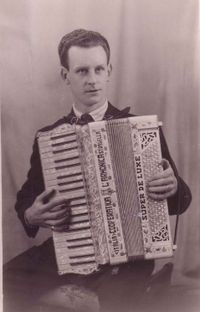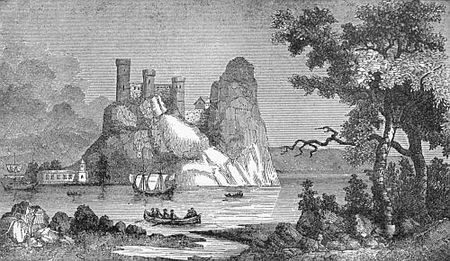Annotation:Rock on the Clyde (The): Difference between revisions
(Created page with "__NOABC__ <div class="noprint"> =='''Back to [[{{BASEPAGENAME}}]]'''== </div> ---- {{#lst:{{PAGENAME}}|abc}} ---- <div style="page-break-before:always"></div> <p><font face="C...") |
Alan Snyder (talk | contribs) m (improve citation) |
||
| (8 intermediate revisions by 2 users not shown) | |||
| Line 7: | Line 7: | ||
---- | ---- | ||
<div style="page-break-before:always"></div> | <div style="page-break-before:always"></div> | ||
<p><font face=" | <p><font face="sans-serif" size="2"> | ||
<div style="text-align: justify; direction: ltr; margin-bottom: 90px; margin-left: 70px; margin-right: 120px;"> | <div style="text-align: justify; direction: ltr; margin-bottom: 90px; margin-left: 70px; margin-right: 120px;"> | ||
<br> | <br> | ||
'''ROCK ON THE CLYDE, THE.''' Irish | '''ROCK ON THE CLYDE, THE.''' AKA and see "[[Brid Harper's (3)]]." Scottish, Irish; Jig (6/8 time). G Major. Standard tuning (fiddle). AABB. [[File:bobbymacleod.jpg|200px|thumb|right|Bobby MacLeod]]The jig was composed c. 1950's by Scottish accordion player and bandleader Bobby MacLeod (1925–1991), and was popularized in Irish repertory by the playing of Belfast fiddler Sean Maguire. | ||
<br> | |||
Dumbarton, the rock on the Clyde. | <br> | ||
The town of Dumbarton was known to the ancient Britons as Alcluith, the ‘rock on the Clyde’, and to the Scots in Dalriada, who spoke Gaelic, as ''Dun Breatann'' - 'the fort of the Britons'. It takes its name from a rocky outcrop on the Clyde that was once a fortress of the Britons of Strathclyde. The rock sits at the end of the River Leven which flows from Loch Lomond. | |||
[[File:rockontheclyde.jpg|450px|thumb|left|Dumbarton, the rock on the Clyde.]] | |||
<br> | <br> | ||
</div> | </div> | ||
| Line 21: | Line 20: | ||
<div class="noprint"> | <div class="noprint"> | ||
== Additional notes == | == Additional notes == | ||
<p><font face=" | <p><font face="sans-serif" size="2"> | ||
<font color=red>''Source for notated version''</font>: - | <font color=red>''Source for notated version''</font>: - | ||
<br> | <br> | ||
<br> | <br> | ||
</font></p> | </font></p> | ||
<p><font face=" | <p><font face="sans-serif" size="2"> | ||
<font color=red>''Printed sources''</font> : - McGuire & Keegan ('''Irish Tunes by the 100, vol. 1'''), 1975; No. 18, p. 5. | <font color=red>''Printed sources''</font> : - | ||
MacLeod ('''Bobby MacLeod's Selection of Country Dance Tunes'''), c. 1955; p. 11. | |||
McGuire & Keegan ('''Irish Tunes by the 100, vol. 1'''), 1975; No. 18, p. 5. | |||
<br> | |||
<br> | |||
</font></p> | |||
<p><font face="sans-serif" size="2"> | |||
<font color=red>''Recorded sources'': </font> <font color=teal> - | |||
Magnetic Music MMR CD 1018, Ross Kennedy & Archie McAllister - "The Gathering Storms" (1997). Mulligan Records, Vinnie Kilduff - "The Boys from the Blue Hill" (1990). "Good Morning to Your Nightcap" (2015). </font> | |||
<br> | <br> | ||
<br> | <br> | ||
</font></p> | </font></p> | ||
<p><font face=" | <p><font face="sans-serif" size="2"> | ||
< | See also listing at:<Br> | ||
Alan Ng's Irishtune.info [https://www.irishtune.info/tune/4496/]<br> | |||
</font></p> | </font></p> | ||
<br> | <br> | ||
Latest revision as of 03:40, 16 November 2021
X: 1 % T:Rock On The Clyde, The T:Brid Harper's [3] R:jig C:Bobby McLeod (1925-1991), Mull, Scotland Z:id:hn-jig-456 M:6/8 L:1/8 K:Em GEF G2A | B2e dB/c/d | edB AGA | BGE AFD | GEF G2A | B2e dBd | edB AGA | BGE E2F :| |: ~g3 fed | ~e3 dBA | ~G3 AGA | BGE EGE | DB,D GAc | BdB g2d | edB AGA | BGE E2F :|

The town of Dumbarton was known to the ancient Britons as Alcluith, the ‘rock on the Clyde’, and to the Scots in Dalriada, who spoke Gaelic, as Dun Breatann - 'the fort of the Britons'. It takes its name from a rocky outcrop on the Clyde that was once a fortress of the Britons of Strathclyde. The rock sits at the end of the River Leven which flows from Loch Lomond.

